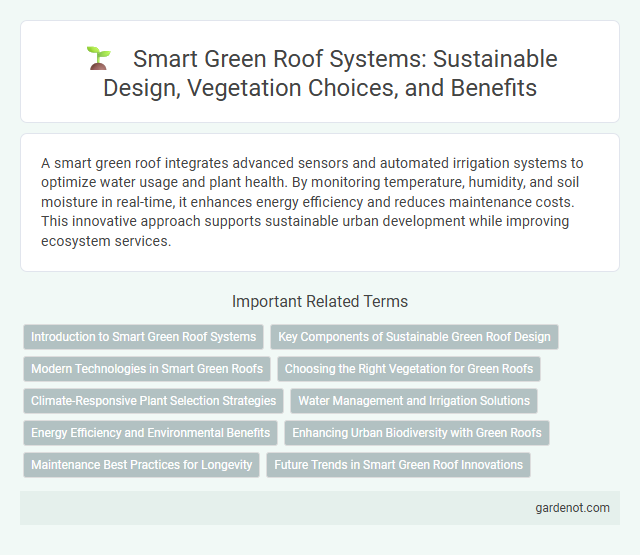A smart green roof integrates advanced sensors and automated irrigation systems to optimize water usage and plant health. By monitoring temperature, humidity, and soil moisture in real-time, it enhances energy efficiency and reduces maintenance costs. This innovative approach supports sustainable urban development while improving ecosystem services.
Introduction to Smart Green Roof Systems
Smart green roof systems integrate advanced technologies such as IoT sensors and automated irrigation to optimize plant health and water efficiency. These systems monitor environmental factors like soil moisture, temperature, and sunlight in real-time, enabling precise resource management. By combining sustainable design with intelligent controls, smart green roofs enhance urban biodiversity and reduce energy consumption in buildings.
Key Components of Sustainable Green Roof Design
Smart green roofs integrate advanced waterproof membranes, lightweight growing media, and drought-resistant vegetation to optimize sustainability and energy efficiency. Incorporating sensors for moisture and temperature monitoring enhances irrigation management and plant health, reducing maintenance costs. The use of recycled materials and modular installation techniques further supports environmental impact reduction and scalability in urban settings.
Modern Technologies in Smart Green Roofs
Smart green roofs integrate modern technologies such as IoT sensors for real-time monitoring of soil moisture, temperature, and plant health, optimizing water usage and maintenance efforts. Automated irrigation systems connected to weather forecasts reduce water waste while promoting sustainable plant growth. Advanced materials, including photovoltaic panels and self-healing membranes, enhance energy efficiency and roof durability in urban environments.
Choosing the Right Vegetation for Green Roofs
Selecting drought-tolerant, low-maintenance plants such as sedums and native grasses enhances the efficiency and sustainability of smart green roofs. These species improve water retention, reduce urban heat island effects, and support local biodiversity while minimizing irrigation and upkeep needs. Optimal vegetation choice directly influences the green roof's environmental performance and lifespan.
Climate-Responsive Plant Selection Strategies
Smart green roofs utilize climate-responsive plant selection strategies to enhance ecosystem resilience and optimize water usage. Selecting drought-tolerant, native, and heat-resistant species reduces irrigation needs and supports urban biodiversity. Integrating plants that adapt to seasonal variations improves thermal regulation and air quality in urban environments.
Water Management and Irrigation Solutions
Smart green roofs integrate advanced water management systems that optimize rainwater harvesting and reduce runoff by utilizing sensors and automated irrigation technologies. These systems monitor soil moisture levels and weather conditions in real time, ensuring precise water delivery that conserves resources while promoting healthy plant growth. Intelligent irrigation solutions adapt to environmental changes, enhancing the sustainability and efficiency of green roof ecosystems.
Energy Efficiency and Environmental Benefits
Smart green roofs enhance energy efficiency by providing superior insulation, reducing cooling and heating demands by up to 30%. These systems utilize sensor technology to optimize water usage, promoting sustainable water management and minimizing runoff. Environmental benefits include improved air quality through pollutant filtration and increased biodiversity, contributing to urban ecosystem restoration.
Enhancing Urban Biodiversity with Green Roofs
Smart green roofs incorporate diverse native plant species and habitat features, creating microhabitats that support pollinators, birds, and beneficial insects in urban environments. These roofs improve urban biodiversity by connecting fragmented habitats and providing essential resources for wildlife amidst city landscapes. Integrating sensor technology optimizes water and nutrient delivery, promoting healthier plant growth and sustaining ecological balance on green roof ecosystems.
Maintenance Best Practices for Longevity
Smart green roof maintenance prioritizes regular inspections to identify and address plant health issues, drainage functionality, and waterproofing integrity. Employing sensor technology for real-time monitoring of soil moisture and temperature optimizes irrigation schedules, reducing water waste and preventing root rot. Seasonal pruning, weeding, and debris removal enhance plant vitality and extend the lifespan of the green roof system.
Future Trends in Smart Green Roof Innovations
Future trends in smart green roof innovations emphasize the integration of IoT sensors and AI-driven systems to optimize water usage and plant health monitoring. Advances in renewable energy technologies enable green roofs to incorporate solar panels, enhancing energy efficiency while supporting biodiversity. Smart materials with self-healing properties and adaptive shading mechanisms are also emerging, improving durability and environmental responsiveness.
Smart green roof Infographic

 gardenot.com
gardenot.com